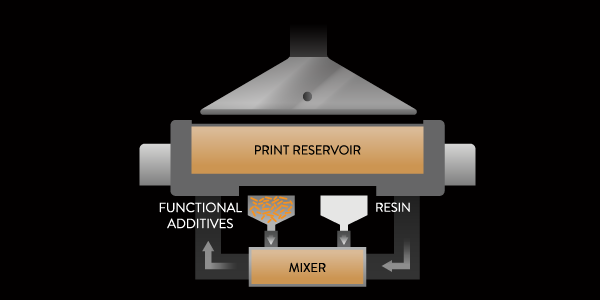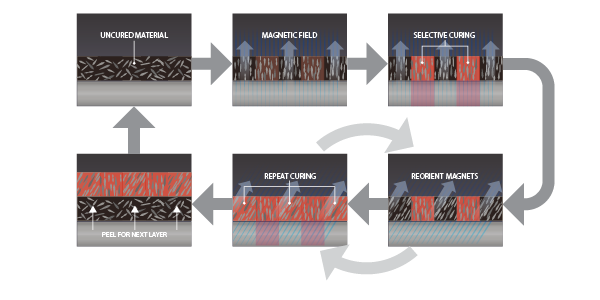3D printing start-up Fortify is set to launch its new CKM (Continuous Kinetic Mixing) technology, which enables improved functionality and mechanical properties in 3D printed photopolymers. The news comes as the vat polymerization specialist expands and sets up shop in its new Boston headquarters to facilitate increased manufacturing needs.
Continuous Kinetic Mixing
Industrial engineers have been enhancing the performance of traditional injection molded polymers for years with the addition of fibers and particles. Fortify aims to implement this processing technique into vat polymerization technology with its new CKM platform, addressing an issue that has persisted in additive manufacturing since its inception.
CKM works by ensuring performance enhancing additives stay uniformly distributed in resins before they are cured, alleviating clustering and sedimentation. This can result in improved strength, stiffness, toughness, wear, and heat deflection temperatures depending on the additives used.

“Material properties are a key factor driving adoption of Additive Manufacturing,” stated Ken Kisner, Global Head of Innovation, 3D Printing, Henkel Adhesive Technologies. “Fortify’s on-board mixing technology is an important step toward satisfying this need. This is a very exciting piece of technology that will open up significant applications across industries.”
Fortify has also recently been successful in extending its use cases to metal injection molding. Namely, ceramic fibers were incorporated into photopolymer resin using CKM technology to fabricate tooling able to withstand the extreme temperatures and pressures generated by the injection molding process.
“For years our customers have been asking us for a better way to prototype parts with our production metal injection molding process. Speed, dimensional accuracy, and production intent processes are critical for our customer’s development efforts,” explains Chris Aiello, Technical Sales Manager at Alpha Precision Group. “Fortify finally showed us a tooling solution that holds up to our MIM process, and checks all the boxes for our customers requirements.”
Fluxprint fiber alignment
Fortify’s CKM technology will be used in conjunction with its Fluxprint process, whereby a magnetic field is applied to the build area during printing. The field aligns all the fibers in that specific layer, which is eventually cured. The orientation of the fibers is secured in the cured resin and the process is repeated for the following layers. This ability to modify fiber orientation on a layer by layer basis gives the user ultimate control over the part’s directional properties.

“Developing Continuous Kinetic Mixing was an integral part of Fortify’s strategy. It will play a critical role in manufacturing functional parts,” said Fortify CEO and Co-Founder Josh Martin. “We’re excited to incorporate this material handling module with our Fluxprint process to solve the application challenges of our customers.”
The CEO goes on to explain that his team takes a comprehensive approach to developing additive solutions. In addition to advanced hardware and software systems, the start-up innovates within materials science to process viscous, heavily loaded polymers. Fortify’s “new class of material” is expected to be well suited for high performance applications.
Fortify’s upcoming Digital Composite Manufacturing (DCM) 3D printer will be the first and only system to incorporate the company’s in-situ mixing CKM and magnetic alignment Fluxprint technologies. The company will begin shipping to select customers this summer.
Fortify’s MIM use case is not the only one to have utilized additive manufacturing and injection molding harmoniously. Last year, Denmark-headquartered manufacturing provider AddiFab used vat polymerization to produce resin molds that could then be injected with liquid plastic or metal in a process it calls Freeform Injection Molding. Elsewhere, in Ireland, researchers from the Athlone Institute of Technology (AIT) have previously used injection molding with FFF to develop custom bilayer tablets capable of releasing drugs in specific quantities.
The nominations for the 2020 3D Printing Industry Awards are now open. Who do you think should make the shortlists for this year’s show? Have your say now.
Subscribe to the 3D Printing Industry newsletter for the latest news in additive manufacturing. You can also stay connected by following us on Twitter and liking us on Facebook.
Looking for a career in additive manufacturing? Visit 3D Printing Jobs for a selection of roles in the industry.
Featured image shows the Fortify team based in Boston. Photo via Fortify.



